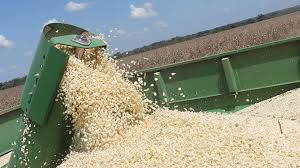Feature -How to feed the planet without destroying the environment
Share

By Johnson Siamachira
Harare (New Ziana) -Imagine a smallholder farmer who prepares his land the same way his father did – by slashing, burning, and clearing the way for the same crops he ate during his childhood and using this agronomic practice to feed his family today. Enter a sustainable agriculture expert in this community and starts telling rural people to farm differently because, well, it would be better for the environment.
Globally, it is becoming increasingly difficult to tell people to farm differently to provide 70 percent more food to feed nine billion people by the year 2050 while still protecting the planet.
Increasing temperatures are putting pressure on farmers while a growing population is placing challenges on the land, with climate variability and change, such as the 2015-2016 El Niño which caused serious food insecurity and environmental damage and will be irreversible.
The world cannot do without agriculture as it remains the key pathway to improving both access to food and income for most vulnerable families.
By 2050, as food production falls and prices rise, the adaptation options that are often talked about become more and more limited, says the CGIAR research programme on Climate Change, Agriculture and Food Security.
Between 2012 and 2050, the population in most of sub-Saharan Africa, for example, would more than double, putting it at 11.3 times its 1950 level.
Innovations such as irrigation or the plough (since circa 6,000 and 3,000 BC) increased productivity, but often deteriorated long-term soil fertility through erosion and other forms of degradation.
When unsustainably practiced, agriculture has led to massive environmental destruction and famine, which have plagued civilizations through the centuries.
It is, therefore, necessary to address food security and the environment to both feed the hungry and save the earth.
However, it has become increasingly clear that there is no one-size-fits-all solution to promote food security while protecting the planet.
A range of techniques, technologies and innovations need to be integrated and adopted, with the agriculture and environment communities becoming pacesetters by coming together to push for sustainable agriculture.
“Achieving food security while saving the environment requires a multi-faceted approach which begins at the production stage until postharvest to reduce food losses and waste,’’ says Dr Blessing Mhlanga, a cropping systems agronomist with the Sustainable Agrifood Systems programme at the Mexico-based International Maize and Wheat Improvement Center(CIMMYT), adding: ‘’Such strategies should be based on regenerating soils, improving soils and production, as well as reducing food losses and enhancing markets. These are critical in achieving economic stability, better health, and resilience to climate shocks.”
This, says Dr Mhlanga, who is stationed at CIMMYT’s Southern Africa Regional Office in Harare, Zimbabwe, involves implementation of sustainable agricultural practices which aim at increasing production while saving the environment. He cites land recovery and revitalization through regenerative practices like agroforestry to improvement of soil using good agricultural practices such as Conservation Agriculture whose practices are based on the principles of minimal soil disturbance, permanent soil cover, and crop rotation.
CIMMYT is working towards a new green revolution-this time for Africa.
Since most farming operations are done manually especially in Africa, reducing labour burden is also key in improving food production as this creates time for other on-farm activities. This can be achieved by introduction of mechanization within farming households.
Dr Mhlanga pinpoints: “In all these strategies, it is important to consider traditional and indigenous knowledge which allows for the tailoring of strategies to current practices, involving and protecting the livelihoods of farmers, local communities, and youth as well as ensuring gender equality.’’
While others would argue that killing or controlling undesired pests is a necessary component of any plan to feed a growing population, these agents can also present major environmental challenges.
These insecticides, called neonics for short, have wreaked havoc on the very bottom of the food chain, from bees, which are essential for pollination, to earthworms, which are essential for soil fertility.
Integrated pest management is the best way forward, according to Dr Mhlanga, because it allows farmers to manage pest damage by doing a cost-benefit analysis and balancing economic and environmental considerations rather than applying chemicals to their crops whether or not they are needed.
A farmer who is requested to stop cutting down trees or introduce new crops altogether, has to do a costs and benefits of whatever changes are introduced to their way of life. Agricultural practices need to show a positive return on investment for farmers, from improved seed varieties to crop rotation or new biological controls.
Good agricultural practices conserve the environment at the same time increase productivity and bring farmers more income. The critical message: Only a farmer who gets more income conserving the environment will stop slash-and-burn agriculture.
In Southern Africa, Conservation Agriculture practices are helping farmers combat growing environmental challenges by enabling them maintain and boost crop yields, protect the environment and increase profits,’’ says Dr Christian Thierfelder, CIMMYT principal cropping systems agronomist. Writing in an article, “Building a sustainable future: A history of Conservation Agriculture in southern Africa,’’ Dr Thierfelder says: “When Conservation Agriculture practices are coupled with water-use efficient and drought tolerant seed varieties, the benefits are even greater.
“Sustainable intensification of agricultural systems and practices such as Conservation Agriculture, have become a necessity for farmers in Africa, where a combination of climate change and unsustainable agricultural practices are undermining land and water resources. This, coupled with an exploding population, makes increasing productivity while conserving the environment absolutely urgent.’’
CIMMYT started its Conservation Agriculture work in Africa in 2004, focusing on Malawi, Mozambique, Tanzania, Zambia and Zimbabwe. “Today, Conservation Agriculture research at CIMMYT in Africa is increasingly focused on adaptation to the changing climate, which is leading to more erratic rainfall, increased heat stress and seasonal dry spells, in an effort to increase the use of climate-resilient cropping systems”, Dr Thierfelder says in the article.
Elphas Chinyanga, a smallholder maize farmer in Shamva district in Mashonaland Central Province in Zimbabwe, was used to the traditional way of farming that his family had practiced for generations, which required clearing a plot of land and burning all plant residues remaining on the soil to get a clean seedbed. But, as land demand increases, this fuels deforestation and depletes soil nutrients. CIMMYT has been working with farmers like Chinyanga since 2004 to adapt sustainable intensification practices like
Conservation Agriculture to his circumstances. In the 2018-2019 cropping season, Chinyanga harvested his best maize yield in the last decade, thanks to the good agricultural practices.
The institution’s work on Conservation Agriculture shows that the practice can significantly increase farmers’ resilience to climate variability and change.
“Combining sustainable intensification practices with improved seed varieties has proved to increase productivity by 30-40 per cent and income by 40-100 per cent under drought conditions”, he said.
But the Conservation Agriculture systems are difficult to scale out if favourable policies and markets are not in place, adds Dr Thierfelder.
“Enhancement of Conservation Agriculture through initiatives such as Pfumvudza /Intwasa(new season) is in motion with training of farmers and other stakeholders in climate-smart crop and livestock production systems including crop and livestock diversification having been given priority”, said Washington Zhakata, director, Climate Change Management Department in Zimbabwe’s Ministry of Environment, Climate, Tourism and Hospitality Industry.
He also said: “Investment in climate- smart agricultural equipment and mechanization is proposed in the future national adaptation planning. Promotion of the uptake of appropriate mechanization and technologies such as low cost/ efficient irrigation systems, and energy efficient systems will be escalated for enhanced climate change adaptation. Uptake of climate related insurance across the agriculture sector is being encouraged, among other adaptation options.”
Collaboration is also key in conserving the environment while stepping up efforts in food security. Agricultural and environmental communities cannot provide more food unless they come together.
By helping farmers to grow food sustainably, the world stands a better chance at both feeding and protecting the earth.
New Ziana







